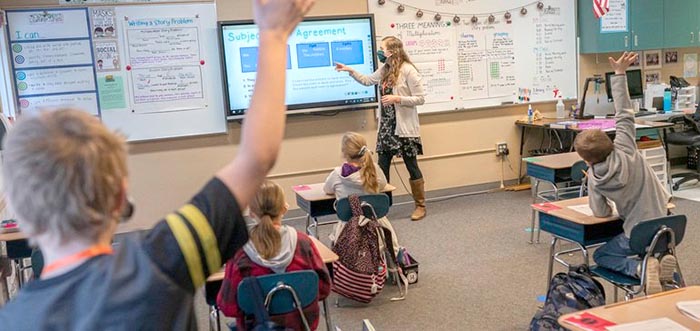
From K-12 Dive
By Naaz Modan
Nov. 24, 2021
Dive Brief:
Nearly half — 48% — of 6,000 teachers surveyed in November said they had considered changing jobs in the past month, up from 32% in June, according to data from Teachers Pay Teachers, an online marketplace for curriculum content created by teachers for teachers.
Slightly over a third of teachers (34%) considered changing careers entirely in the past month. Additionally, 11% said they considered taking a leave of absence.
Areas teachers listed as needing administrators’ support included providing a budget for teaching materials, addressing student behaviors, listening to teachers’ concerns, and providing more planning time.
Dive Insight:
Teacher burnout has been well-documented over the course of the pandemic.
Just last month, a MissionSquare Research Institute survey of 1,203 state and local government employees conducted in May reported teachers were more likely than other government employees to express dissatisfaction with their jobs. In that survey, school employees reported higher levels of anxiety (34%), stress (52%) and burnout (52%) during the COVID-19 pandemic than other government employees. By comparison, 29% of other government workers reported feeling anxious, 35% being stressed, and 34% feeling burnt out.
The most recent findings from Teachers Pay Teachers confirm findings of a National Education Association survey released last year that showed 1 in 3 teachers were considering resigning or retiring earlier due to COVID-19. A separate RAND survey showed the overall likelihood was 1 in 4 after the 2020-21 school year, compared to the pre-pandemic average of 1 in 6. Among Black teachers, 43% reported being more likely to exit the industry early.
In the months following school closures, many expressed concern about teachers leaving the profession in droves. This concern may have been untrue at the time — analysts speculated teachers were staying put for financial security.
However, that seems to be changing. An analysis by Chalkbeat showed out of 20 of the largest school districts, 18 began the year with teacher shortages — some much steeper than reported in previous years.
According to pre-pandemic projections from the U.S. Bureau of Labor Statistics, 270,000 elementary and secondary teachers were already expected to leave their occupation each year, on average, from 2016 to 2026.
While some degree of teacher fatigue existed prior to the pandemic because of staff shortages and large class sizes, COVID-19 sparked an avalanche of calls for administrators to safeguard against such conditions leading to turnover. Some leaders chose to provide social-emotional training and awareness not only for student well-being, but also for staff well-being.
“We know that when educators thrive, students thrive and vice-versa,” Tricia Maas, a senior research scientist at the Committee for Children, told K-12 Dive this past summer.
In releasing the new Teachers Pay Teachers findings, vice president of content Michelle Cummings called for school leaders to support their teachers. “Educators can’t meditate their way out of this crisis,” Cummings said in a statement. “Messages of self-care for teachers are insufficient without also providing more resources and more time.”
She acknowledged that school and district leaders recognize teachers’ need for support and are working to address it. Some solutions include offering days off to recharge, Cummings said.
“Structural change is needed to give teachers and administrators greater voice, choice, and agency in order to recruit and retain talent in this vital profession,” Cummings said.
Photo: Nathan Howard via Getty Images
Read this and other stories at K-12 Dive

